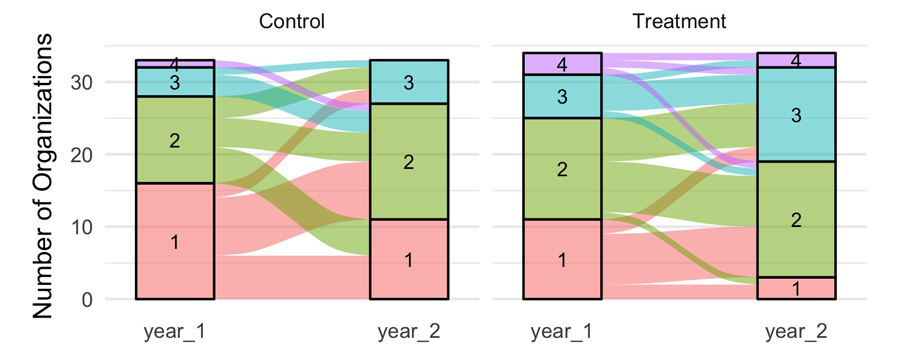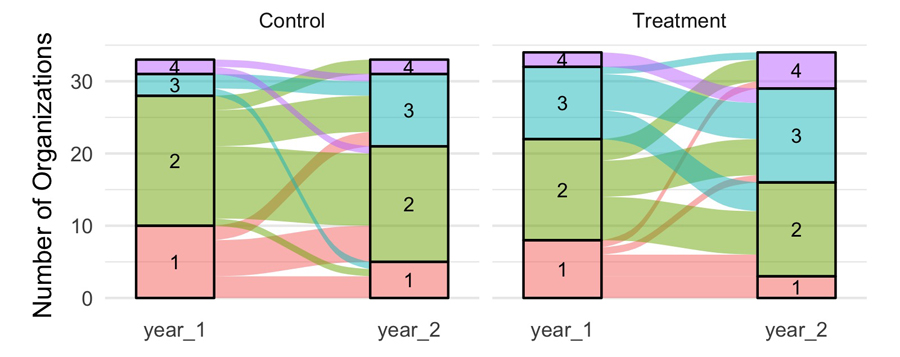Our team wanted to evaluate our impact, so we applied a new framework to find answers.
Every social organization, GlobalGiving included, needs to know if it’s having an impact on the communities it serves. For us, that means understanding the ways in which we are (or aren’t!) helping our nonprofit partners around the world improve their own effectiveness and capacity to create change, regardless of the type of work they do.
Without this knowledge, social organizations can’t make informed decisions about the strategies to use to deliver their services. Unfortunately, this kind of rigorous impact evaluation is usually quite expensive and can take years to carry out. As a result, most organizations struggle to evaluate their impact.
We knew the challenges going into our own impact research would be substantial, but it was too important for us not to try.
Do organizations with access to GlobalGiving’s services improve their performance differently than organizations that don’t? Are there particular focus areas where GlobalGiving is having more of an impact than others?
Ideally, we’d randomly assign certain organizations to receive the “treatment” of being part of GlobalGiving and then compare their performance with another randomly assigned control group. But, we can’t just tell random organizations that they aren’t allowed to be part of our community. So, instead we compared a treatment group—organizations that have completed the GlobalGiving vetting process and become full partners on the website—with a control group of organizations that have successfully passed the vetting process but haven’t joined the web community. Since we can’t choose these groups randomly, we had to ensure the organizations in each group are as similar as possible so that our results aren’t biased by underlying differences between the control and treatment groups.
To do this, we worked only with organizations based in India. We chose India because we have lots of relationships with organizations there, and we needed as large a sample size as possible to increase confidence that our conclusions are reliable. India is also well-suited for this study because it requires organizations to have special permission to receive funds from overseas under the Foreign Contribution Regulation Act (FCRA). Organizations must have strong operations in place to earn this permission. The fact that all participant organizations are established enough to earn both an FCRA certification and pass GlobalGiving’s own high vetting standards means that any differences in our results are unlikely to be caused by geographic or quality differences.
We also needed a way to measure nonprofit performance in a concrete way. For this, we used the “Organizational Performance Index” (OPI) framework created by Pact. The OPI provides a structured way to understand a nonprofit’s capacity along eight different categories, including its ability to deliver programs, the diversity of its funding sources, and its use of community feedback. The OPI scores organizations on a scale of 1 (lowest) to 4 (highest). With the help of a fantastic team of volunteers in India, we gathered two years of OPI data from both the treatment and control groups, then compared how their scores changed over time to get an initial indicator of GlobalGiving’s impact.
The most notable result we found was that organizations that were part of GlobalGiving demonstrated significantly more participatory planning and decision-making processes (what we call “community leadership”), and improved their use of stakeholder feedback to inform their work, in comparison to control group organizations. We did not see a similar significant result in the other seven categories that the OPI tracks. The easiest way to see this result is to visualize how organizations’ scores shifted over time. The chart below shows differences in target population scores—Pact’s wording for “community leadership and feedback.”
Differences in Target Population Score Changes

For example, look at the organizations that started out with a score of two in the control group on the left. Roughly one third of those increased their score to three, one third stayed the same, and one third had their scores drop to one. In contrast, in the treatment group on the right, nearly half the organizations increased their scores and about half stayed the same, while only a tiny fraction dropped. You can see a similar pattern across the two groups regardless of their starting score.
In contrast, here’s the same diagram for another OPI category where we didn’t see a statistically significant difference between the two groups. There’s not nearly as clear a pattern—both the treatment and control organizations change their scores about the same amount.
Differences in Delivery Score Changes

For more technical details about our research design process, our statistical methodology, and the conclusions we’ve drawn, please check out the full write-up of this work, which is available on the Social Science Research Network.
GlobalGiving spends lots of time focusing on helping organizations use feedback to become more community-led, because we believe that’s what delivers greater impact.
Our initial finding—that our emphasis on feedback is having a measurable impact—is an encouraging sign.
On the other hand, we didn’t see that GlobalGiving was driving significant changes in any of the other seven OPI categories. Some of these categories, like adherence to national or international standards, aren’t areas where GlobalGiving focuses much. Others, like how well an organization learns over time, are closely related to what we do (Listen, Act, Learn. Repeat. is one of our core values). We’ll need to continue to explore why we’re not seeing results in these areas and, if necessary, make adjustments to our programs accordingly.
Putting together an impact study, even a smaller one like this, is a major undertaking for any organization. Many organizations talk about applying a more scientific approach to their impact, but few nonprofits or funders take on the challenge of carrying out the research needed to do so. This study demonstrates how organizations can make meaningful progress towards rigorously measuring impact, even without a decade of work and an eight-figure budget.
If your organization is considering something similar, here are a few suggestions to keep in mind that we’ve learned as a result of this project:
We’re pleased about what we’ve learned about GlobalGiving’s impact, where we can improve, and how we might build on this initial work, and we can’t wait to continue to build on this progress moving forward in service of improved outcomes for our nonprofit partners worldwide.
Featured Photo: Give Them a Future: Tribal Education in India by AgragameeFind exactly what you're looking for in our Learn Library by searching for specific words or phrases related to the content you need.